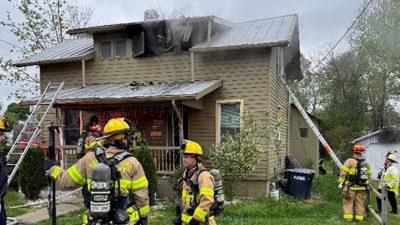
School shootings garner a lot of attention, and often lead parents to wonder if their children are safe when they put them on the bus each morning. A recent incident at Berkeley Glenn Elementary School in Waynesboro had one family on edge due to a supposed “kill list” where their child, they were told, was allegedly #1 on the list.
While it is unsettling to hear this news as a parent or educator, an expert in school violence from the University of Virginia said the fear of violence can lead school divisions to overreact to student threats and perceive a student as much more dangerous than they actually are.
“Our controlled studies found that schools using threat assessment can resolve numerous threats without a violent incident and that they can reduce problems like bullying and fighting,” said Dewey G. Cornell, Ph.D., Virgil Ward Professor of Education in the School of Education and Human Services at UVA. “Crime statistics show conclusively that schools are actually much safer than the public perceives.”
Students are safer from violent crime when they are in school than if they were in most other places, such as a store or restaurant or someone’s home, Cornell said.
“School shootings are terrible events that attract a great deal of attention, but they give a distorted picture of schools,” he said.
The last time a student was murdered in a Virginia public K-12 school was in 1998, Cornell said.
“Some threats lead to a fight, and very rarely anything more serious,” Cornell said.
National statistics from the Centers for Disease Control indicate that more than 98 percent of homicides of school-age youth take place outside of school and less than 2 percent in a school.
While a “kill list” sounds intimidating, Cornell said that research shows it is common for elementary school students to make threats to kill someone, and nearly all of these threats are not serious. Threats to kill are more common in elementary schools than secondary schools.
Most threats by elementary school students can be resolved easily and do not require school removal, Cornell said.
“In most cases, a school counselor can help the students resolve a conflict or dispute that gave rise to the threat,” he said.
While threats made at the elementary school level may rarely lead to violence, a threat assessment should be completed in all incidents.
“All threats are not serious threats,” Cornell said. “Sometimes threats are jokes, expressions of frustration or efforts to intimidate someone without a serious intent to attack or harm someone.”
In the case of a serious threat, law enforcement may be engaged, and protective actions may be required.
“But in most cases, a threat by an elementary school student is not serious and can be handled with discipline and counseling,” he said.
Engaging parents in the resolution
In the incident in Waynesboro Public Schools, the parent said they were contacted after school by the principal and told what happened. The parent said they asked about discipline and were told there would be consequences for the student. The parent was upset that the school couldn’t tell them more, and that the child who allegedly made the threat was sharing a table with the victim days later.
“The school should be sharing information with parents to allay their concerns,” said Cornell.
Often, he said, the problem is the fear of school violence that accompanies a threat.
“It is understandable that a parent would be concerned if their child was threatened, and they did not know what happened in response,” Cornell said. “We recommend that schools share information with all parents who have students involved in a threat incident.”
There are some restrictions imposed by state and federal laws such as the Family Educational Rights and Privacy Act, but they allow some sharing of information under appropriate circumstances.
Cornell said the victim’s parents should be involved in the process of resolving the concern.
“We don’t want parents to be in the dark when there is a matter of student safety,” he said. “School threat assessment teams are trained to work with parents in a collaborative manner to resolve a threat.”
Virginia mandate for threat assessments
Virginia Public Schools are mandated by law to have threat assessment teams for this purpose, he said. Virginia was the first state to make this requirement in 2013, and many states have since followed suit.
“All K-12 schools should use behavioral threat assessment when a student makes a threatening statement or engages in threatening behavior,” Cornell said.
In schools with a zero-tolerance policy, a threat may require automatic punishment.
Instead, a behavioral threat assessment team takes a problem-solving approach to the situation – evaluating what happened, looking at the context of the incident and taking appropriate action based on the seriousness of the action and whether the student poses a risk of harming others.
A behavioral assessment might also try to find the root cause of why the student made the threat: bullying, depression, paranoia or other common problems.
Schools who utilize a threat assessment model show a decline in student suspensions and expulsions.
Instead of disciplining the student, they may increase the monitoring of the student and consult with parents. Until a safety plan is in place, the team may recommend a brief removal of the student from the classroom with the student moved to a supervised setting.
Waynesboro Public Schools follow the Virginia mandate for a behavioral threat assessment in cases like this, said Ryan Barber, assistant superintendent. Barber said WPS has “a detailed threat assessment process that is completed by a multi-disciplinary team” that exceeds the requirements of the state.
“We’ve employed more school psychologists, school social workers, school counselors, behavior analysts and social/emotional learning educators,” Barber said. “All of these professionals work to increase the ability of our students to fully access the learning environment with the support they need to be more successful. Many times, if there are concerns related to safety, detailed safety plans are developed so any safety threat is mitigated to the greatest extent possible.”
Cornell, a leader in the National Center for School Safety research project, said that a state mandate for a threat assessment model in schools isn’t enough; he also thinks the state should have a role in monitoring schools and their teams to ensure they are carrying out threat assessments effectively.
“We are concerned that some schools are not conducting threat assessments,” Cornell said. “The shooting at an elementary school in Newport News last year seems to represent a failure to use threat assessment that could have averted a shooting.”
Related stories
Threats among elementary school children require intervention ‘to break the cycle’ of behavior
Virginia fourth-grader allegedly on ‘kill list’; parent outraged at school’s response
Virginia mother of 6-year-old who shot teacher pleads guilty in federal court










